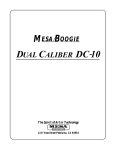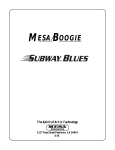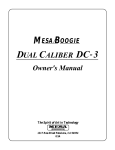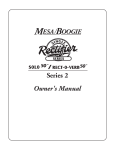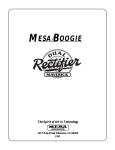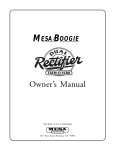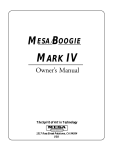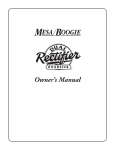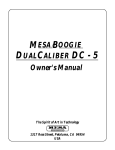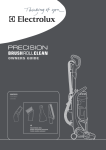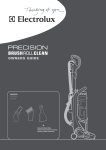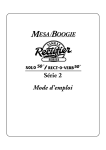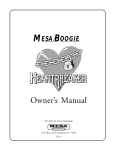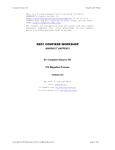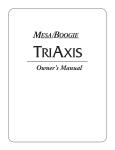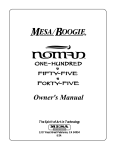Download Mesa/Boogie RECT-O-VERB 50 User's Manual
Transcript
MESA BOOGIE Owner's Manual The Spirit of Art in Technology 1317 Ross Street Petaluma, CA 94954 USA Greetings From The Home Of Tone YOU, the smart player and all around intuitive human, have put your trust in us to be your amplifier company. This is something we do not take lightly. Our reward is that we’ve made a classic amplifier and by choosing this amplifier, you have become part of the Mesa family...Welcome! Our goal is to never let you down. Your reward is that you are now the owner of an amp bred of fine all tube heritage...benefiting from the many patented pioneering Mesa/Boogie circuits. Feel confident, as we do, this amp will inspire many hours of musical satisfaction and lasting enjoyment. It was built with you in mind, by players who know the value of a fine musical instrument and the commitment it takes to make great music. The same commitment to quality, value and support we make to you...our new friend. PRECAUTIONS: Table of Contents OVERVIEW: ____________________________________________________________________________ 1 INSTANT GRATIFICATION (3 DEMONSTRATION SETTINGS) __________________________________________________________ 2 CHANNEL / MODE SELECT: RHYTHM CHANNEL: CLEAN & PUSHED ___________________________________________________ 3 LEAD CHANNEL: VINTAGE & MODERN ____________________________________________________ 3 CONTROLS: GAIN __________________________________________________________________________________ 3 TREBLE _______________________________________________________________________________ 4 MIDDLE _______________________________________________________________________________ 4 BASS _________________________________________________________________________________ 4 PRESENCE ____________________________________________________________________________ 5 MASTER _______________________________________________________________________________ 5 OUTPUT CONTROL _____________________________________________________________________ 6 SOLO CONTROL _____________________________________________________________________ 6 / 7 TOGGLE SWITCHES: STANDBY ______________________________________________________________________________ 7 POWER _______________________________________________________________________________ 7 BACK PANEL: AC RECEPTACLE _______________________________________________________________________ 8 FUSE _________________________________________________________________________________ 8 SLAVE OUT ____________________________________________________________________________ 8 SPEAKERS ____________________________________________________________________________ 9 FX LOOP: SEND / RETURN / MIX _________________________________________________________ 9 REVERB: RECT-O-VERB COMBO & RECT-O-VERB HEAD ____________________________________ 9 CHANNEL SELECT TOGGLE ______________________________________________________________ 9 FACTORY SAMPLE SETTINGS PAGE _________________________________________________ 10 / 11 PERSONAL SETTING PAGE _________________________________________________________ 12 / 13 TUBE TASK CHART ____________________________________________________________________ 14 TUBE MAINTENANCE ______________________________________________________________ 15 / 16 SPECIAL ARTICLE REGARDING TUBE BIASING By Randall Smith ______________________ 17/ 18 / 19 PARTS SHEET _________________________________________________________________________ 20 Your MESA/Boogie Amplifier is a professional instrument. Please treat it with respect and operate it properly. USE COMMON SENSE AND ALWAYS OBSERVE THESE PRECAUTIONS: Do not expose amplifier to moisture, rain or water, direct sunlight or extremely high temperatures. Always insure that amplifier is properly grounded. Always unplug AC power cord before changing fuse or any tubes. When replacing fuse, use only same type and rating. Avoid direct contact with heated tubes. Insure adequate air circulation behind amplifier. Keep amplifier away from children. Be sure to connect to an AC power supply that meets the power supply specifications listed on the rear of the unit. If there is any danger of lightning occurring nearby, remove the power plug from the wall socket in advance. To avoid damaging your speakers and other playback equipment, turn off the power of all related equipment before making the connections. Do not use excessive force in handling control buttons, switches and controls. Remove the power plug from the AC mains socket if the unit is to be stored for an extended period of time. Do not use solvents such as benzene or paint thinner to clean the unit. Wipe off the exterior with soft cloth. Be sure to have the warranty card for this product filled out by the store at which it was purchased and return to Mesa Engineering. YOUR AMPLIFIER IS LOUD! EXPOSURE TO HIGH SOUND VOLUMES MAY CAUSE PERMANENT HEARING DAMAGE NO USER SERVICEABLE PARTS INSIDE: Refer service to qualified personnel. Always unplug AC power before removing chassis. EXPORT MODELS: Always insure that unit is wired for proper voltage. Make certain grounding conforms with local standards. READ AND FOLLOW INSTRUCTIONS FOR PROPER USAGE. Table of Contents Overview: Congratulations on your choice of the SINGLE RECTIFIER 50. You have purchased a handbuilt instrument of the finest quality and craftsmanship. A unique blend of yesteryears’ black magic power section design combined with our race-shop approach to finely tuned, high gain pre-amp circuitry leaves the RECT-O 50 standing alone...instantly a classic destined for vintage status. With two channels housing four definitive and distinctly different Modes, a complete array of amazing guitar sounds can be obtained quickly and easily. Looking to the Rear Panel assures that all your interfacing needs are covered. A Parallel Effects Loop with a MIX control provides tone insurance for even those questionable effects. To use the SINGLE RECTIFIER 50 in larger rack systems, or to interface to other power sections, the SLAVE jack and is a welcome feature. Two speaker jack combinations have been provided - two 4 Ohm and one 8 Ohm - to ensure the proper impedance match to many types of speaker enclosures. The other features will prove to be quite valuable to you and further along in this manual they are covered extensively. FRONT VIEW HEAD VERSION: SOLO HEAD 50 Instant Gratification Demo Settings CLEAN RHYTHM ON ON PUSHED MASTER PRESENCE BASS MID TREBLE GAIN VINTAGE FT.SW POWER SOLO STANDBY INPUT OUTPUT LEAD MODERN REAR VIEW HEAD VERSION: SOLO HEAD 50 WARNING: SOLO HEAD 50 ALL-TUBE AMPLIFIER Unplug power before replacing fuse or removing bolts mounting chassis. HANDBUILT IN PETALUMA, CALIFORNIA SET TO RHYTHM WHEN USING FOOTSWITCH EFFECTS LOOP SPEAKERS SLAVE RHYTHM FUSE FUSE 10% WARNING: To reduce risk of fire or FX MIX CAUTION: To reduce risk of fire or electric shock, do not remove cover. No userserviceable parts inside. Refer servicing to qualified personnel. electric shock, replace fuse with same type and rating only. Do not expose this unit to rain or moisture. LEAD 10 0% RETURN SEND 8 OHM 4 OHM 4 OHM PATENTED 4,211,893 AND OTHERS PENDING OUT POWER 120 V~ 50-60 Hz 2.5 A FUSE 2.5 A SLO BLO REAR VIEW - HEAD VERSION FRONT VIEW COMBO VERSION: RECT-O-VERB 50 CLEAN RHYTHM ON ON STANDBY POWER PUSHED GAIN TREBLE MID BASS MASTER PRESENCE VINTAGE INPUT OUTPUT LEAD MODERN REAR VIEW COMBO VERSION: RECT-O-VERB 50 WARNING: Unplug power before replacing fuse or removing bolts mounting chassis. SPEAKERS SET TO RHYTHM WHEN USING FOOTSWITCH EFFECTS LOOP SLAVE 1 REVERB 2 FUSE FUSE POWER 120 V~ 50-60 Hz 2.5 A FUSE 2.5 A SLO BLO FT.SW 10% OUT FT.SW. LOCATED UNDER CHASSIS 8 OHM 4 OHM 4 OHM RHYTHM 10 0% FX MIX RETURN SEND PATENTED 4,211,893 AND OTHERS PENDING PAGE 1 WARNING: To reduce risk of fire or electric shock, replace fuse with same type and rating only. Do not expose this unit to rain or moisture. CAUTION: To reduce risk of fire or electric shock, do not remove cover. No userserviceable parts inside. Refer servicing to qualified personnel. LEAD RECT-O-VERB COMBO & HEAD FRONT PANEL: First familiarize yourself with the layout of the Front Panel. Next, remove the footswitch from the transport pouch located inside the cabinet ( combo ) and connect it to the proper jack. RECT-O-VERBS use a DIN jack located on the rear of the chassis directly behind the label FOOTSWITCH. SOLO 50 HEADS use a 1/4 jack on the right side of the Front Panel. If the footswitch is not available, you may select the two channels via the manual Channel Select toggle located on the far left of the Rear Panel. CLEAN RHYTHM ON ON PUSHED MASTER PRESENCE BASS MID TREBLE GAIN VINTAGE FT.SW POWER STANDBY SOLO INPUT OUTPUT LEAD MODERN SOLO 50 HEAD VERSION POWER-UP: First remove the protective covers from the tubes (plastic webbing) before connecting the A.C. cord to a power receptacle. Connect your favorite guitar to the instrument INPUT jack. Flip the POWER switch to the ON position while leaving the STANDBY switch set to STANDBY.” (It is always a good idea to practice this start up procedure as at least 30 seconds of warm-up time lessens the shock on cold power tubes, thus prolonging their life substantially.) Next, using the example below as a guide, set the controls as illustrated and flip the STANDBY switch to the ON position to listen to the two distinctly different channels using either the footswitch or the Channel Select toggle switch as mentioned in the paragraph above. Before discussing each control, let’s audition a couple of possible ways the two channels might be configured for footswitchable sounds. The first example leans towards a more traditional format with a clean rhythm dialed up on the top RHYTHM ( Green ) channel and a moderate gain, vintage style solo sound dialed up on the bottom LEAD ( Red ) channel. CLEAN RHYTHM ON ON PUSHED MASTER PRESENCE BASS MID TREBLE GAIN VINTAGE FT.SW POWER STANDBY SOLO INPUT OUTPUT LEAD MODERN This second example leans in a more aggressive direction with the top channel switched to PUSHED for a crunchy high gain rhythm sound and the bottom channel switched to MODERN for a blistering lead voice. INSTANT GRATIFICATION: Demo Setting #2 CLEAN RHYTHM ON ON PUSHED MASTER PRESENCE BASS MID TREBLE GAIN VINTAGE FT.SW POWER STANDBY SOLO INPUT OUTPUT LEAD MODERN NOTE: CAUTION - REDUCE THE OUTPUT LEVEL CONTROL BEFORE PLAYING THESE SOUNDS AS THE ADDED GAIN INCREASES VOLUME LEVELS. Now that you’ve heard the SINGLE RECT-O 50’S two channels, let’s move on to understanding the controls and their interactive roles in achieving the sounds that you want to hear. PAGE 2 CHANNEL / MODE SELECT: Each channel of your amplifier contains two different Modes of operation that may be selected depending on your application. In this way you may decide to use the channels for their most obvious sounds or with the flick of a switch - invert the channels for the opposite sound style. The voicing of the modes is accomplished by rerouting and reconfiguring the circuit in both pre-amp and power sections of the amplifier. Here are the choices; CLEAN RHYTHM ( Top ) Channel CLEAN: (toggle up) delivers a sparkling rendition of the classic black face style rhythm sound with the added dynamic response of the RECT-O 50’S super quick driver circuit. This is a low gain mode that is optimized HEAD VERSION for fast clear attack, huge breathy low end response and the impression of headroom far in excess of the conservative 50 watt rating. It may also be cranked to produce a vintage style clip when the GAIN control is maxed that is relatively uncolored when compared to the PUSHED sound. This is preferable when you wish to retain more of the guitars’ natural character and don’t need thick saturation. PUSHED FT.SW INPUT PUSHED: (toggle down) adds substantial gain by saturating another tube stage and revoicing the treble frequencies to respond much better with overdriven sounds. A by-product of adding this extra gain is a masking of some of the sparkling highs - which lends a sort of natural tube compression, making PUSHED an alternate and quite amazing lead mode - along with its obvious crunch rhythm potential. LEAD ( Bottom ) Channel VINTAGE: (toggle up) is the creamier, warmer sounding of the RECT-O’S two lead modes and therefore excels at single note solo sounds by producing a rounder attack with more elasticity as the notes decay. Often first misinterpeted by short demos, this mellower blend becomes many owners’ favorite sound as they explore the ever changing harmonic content and precious attack envelope. VINTAGE FT.SW INPUT MODERN HEAD VERSION MODERN: (toggle down) is emphasized attack. This is by far, the most aggressive, forward, in your face sound in the RECT-O’S quiver of modes. By stripping negative feedback from the power section and revoicing the pre-amp to respond with a more urgent feel in the time domain, a beast is unleashed and the amp that was moments ago singing with a sweet languid voice, becomes downright dangerous. NOTE: It is normal to hear a volume increase when the MODE SELECT is toggled between the VINTAGE and MODERN Modes in the LEAD channel. This is a result of the substantial change in power section sensitivity as negative feedback is removed and applied with the change in modes. CONTROLS: GAIN: Like most amplifiers, the GAIN control in each channel determines its sensitivity and overall tonal characteristics. It meters the amount of Gain that your guitar signal will produce. In the RECT-O 50, we paid special attention to the amount and frequencies of gain present in each mode, making sure the whole range of available gain is musically usable. We also worked diligently with our suppliers to develop pots with tapers useful to players that require that touch sensitive relationship of input signal level to gain saturation. An essential ingredient to a great CLEAN amps expressive nature. To maximize your expression, spend time learning the different regions of the GAIN control in each mode and tonal colors they enhance. Almost more PUSHED or certainly equal to the tone controls - the GAIN control shapes your sound. GAIN VINTAGE FT.SW INPUT As a general guideline, the lower regions of this control produce brighter, tighter, faster sounds with enhanced dynamics...the higher the GAIN control setting - the warmer, fuller, MODERN more saturated and more compressed ( less dynamic ) the sound becomes. Remember HEAD VERSION that with this sensitive control the entire character of the channel is determined. Because the RECT-O 50 is a hyper-tuned gain machine some of the best and most musical sounds are found in the middle ranges of this control. In other words...more is not always better. PAGE 3 CONTROLS: (Continued) TREBLE : As with most guitar amplifiers, the TREBLE control is the strongest of the three rotary tone controls. Its setting on the RECT-O 50 determines the blend and strength of the MIDDLE and BASS controls. Set high, it is the dominant control, thus minimizing the amount of Mid and Bass that would be possible in the mix. Set low, the TREBLE becomes the recessive control and a warmer, darker blend is produced. Dial with care. Subtle tweaking of this control tends to produce the best results. TREBLE GAIN HEAD VERSION MIDDLE : The MID control determines the blend of midrange punch and boldness. It also has a great deal to do with how a sound feels to play. Setting the Midrange low scoops the attack, making the sound and feel more liquid and resilient. Setting the MID control higher introduces more punch and authority, helping sounds cut through a mix better. Setting the Mids very high may make the strings feel a little stiffer and less spongy. Keep this in mind when dialing up your sounds so that you can retain the best feel on the strings, allowing you to always play your best. MID TREBLE In the PUSHED Mode, the MID control set low produces a sweeter, smoother clip and really allows this sound to purr. Try the GAIN control set at around or so and the MID control set at around to for a tasty blend of smooth dynamic overdrive. Add Treble to focus the attack and fatten with the BASS control. Presence will “Open up” or compress this beyond vintage sound that howls with authenticity. This has to be one of the best sounds in the RECT-O 50 ! HEAD VERSION At high Gain settings in either the Vintage Orange or Modern Red Modes, the MID control dials in punch and aggression. For the tightest crunch chording, set the MID control high, say around . To make single notes feel juicier and more liquid, reduce the MID control to around or so. In the Modern Red Mode, using the Mid higher and in conjunction with the PRESENCE control also set high, delivers a down right ugly crunch that’s huge and angry - not fit for the meek! This setting also sounds great and becomes easier to play and more elastic feeling with the GAIN control set at or higher. BASS: This control blends in the lower frequencies and its effectiveness, again, depends on the setting of the TREBLE control. It should be set with moderation as extreme settings in either low or high directions can produce an unbalanced tone. Be “especially” careful in higher Gain settings of either channel. Too much Bass will cause a flabby unfocused sound. BASS MID Try setting the BASS control to for clean sounds in the clean Mode and or below when dialing up high gain overdriven sounds in this Mode. In the LEAD Modes, try setting the BASS somewhere between and . These settings will vary with the amount of Gain and Treble you have dialed up. HEAD VERSION PAGE 4 CONTROLS: (Continued) PRESENCE: These are controls that work in the power section to reduce attack and brightness. They work on a different frequency than the TREBLE control, and depending on the mode chosen and the amount of Gain dialed up, can sound higher or lower than the Treble frequency. BASS PRESENCE HEAD VERSION In the RHYTHM mode it dials in sparkle and shimmer, letting clean sounds cut through better. Balance the Treble and Presence until the desired blend is reached. When you have high gain or distortion sounds dialed up, you will find it very helpful in darkening and compressing the sound for single note work. Set the PRESENCE control low and this compression will also focus the notes and omit any unwanted “buzzy” frequencies. For high gain chording try higher settings of the PRESENCE control to bring out the harmonic haze. In the LEAD channel the Presence circuitry is quite advanced because it switches from one type of Presence located in one part of the power section, to a different Presence circuit located earlier in the preamp section. This switching makes the complete transformation possible that delivers the VINTAGE Mode authentically and the Modern high gain Mode absolutely over the top! In the Vintage Mode the Presence is similar in strength and frequency to that of the Green RHYTHM channels’ CLEAN Mode. Set low it warms up single notes ‘til they purr. At high settings it adds bounce and improved dynamics that can really help when you want to back your guitar volume down and “clean up” for rhythm playing. When the Red Modern high gain Mode is called up, the PRESENCE control makes the move to a new place in the circuit and gets revoiced to work on a lower frequency. Just right for adding attack and urgency, this Presence is the aggression control. It is normal for high settings of this control to make Modern Red seem extremely loud in comparison to the other Modes. This is a result of “unclamping” what worked as the Presence in the other three Modes and letting the RECT-O’S ponies run free. It is in fact, the loudest setting on the amplifier. Use this Presence with discretion as it can make for some ear damaging, almost harsh sounds if set too high. Try the Modern Mode with the GAIN control set high, around to . Dip the MID control to then increase the Presence to dial in the right attack and blend of aggression. You may want to play with the balance between the MID and PRESENCE controls as they are somewhat similar in that they are very powerful and dominant in Modern. With these two controls dialed right, Modern is to this day the most huge and heinous crunch we’ve come across. When you hear this, you will probably won’t believe that this could be the same amp that moments ago was crying the blues with such mournful conviction. MASTER: A simple control found on most amps today, these serve to balance the playing level of the two channels. They enable the pre-amps GAIN control to be used in a wide range of settings, while never having to affect the listening level. On the SINGLE RECTIFIER 50 these MASTERS serve another purpose as well. When the FX LOOP is in use, these MASTER controls double as Effects Loop Send Level controls. MASTER PRESENCE This is not their primary function, but the setting here does affect the channels’ Send strength. We have found the middle ranges through to be vary well behaved for most effects. Setting the MASTERS in this region should make for trouble free effects interfacing when using the loop. HEAD VERSION PAGE 5 CONTROLS: (Continued) OUTPUT: This control determines the overall output volume level of the amplifier. After the GAIN controls have been set for the desired sound style and the two channels levels have been balanced with the channel MASTER controls, the OUTPUT control allows you to change the playing level by adjusting a single control. The OUTPUT control is also wired as the Effects Loop Return Level control. Should you ever use your RECT-O 50 as a power amp alone by inserting a signal into the RETURN jack, the OUTPUT control will serve as the master level control. SOLO OUTPUT NOTE: When using the EFFECTS RETURN as an input - to use the RECT-O 50 as a power amp - the SOLO control can be used to attain a footswitchable boost if the Footswitch is connected. It is wired in parallel to the OUTPUT control and therefore also controls the volume of the power section. NOTE: The Effects Loop RETURN jack can serve as a power amp input so that you may use your SINGLE RECTIFIER as a power amplifier for either stereo reproduction or to incorporate additional pre-amps. HEAD VERSION While the possibilities for this type of application are virtually limitless, there are a few things to remember that will help you when interfacing to the RECT-O for use as a power amp only; 1.) Connect “Dummy” plug or loose cable to SEND jack. ( This prevents any possible loading that could result in diminished RETURN sensitivity.) 2.) The OUTPUT Level will be the only active control on the Front Panel (the PRESENCE control of the top / Rhythm channel will be active only when that channel is engaged - see #3 ) 3.) The SOLO control may be used to footswitch to a pre-determined amount of boost when the footswitch is connected. 4.) The lower LEAD channels’ MODERN mode - as part of its voicing - utilizes substantially less negative feedback in the power stage creating a scenario of greatly increased power sensitivity. This internal revoicing produces amazing results in the lead sounds and requires a sophisticated network of elements to switch to prevent the increased power sensitivity from blowing you out of the room as the LEAD channel is toggled between VINTAGE and MODERN. Therefor, we recommend selecting the top / RHYTHM channel when you wish to use the RECT-O as a power amp. The more conventional power sensitivity of this channel will be the most compatible with external sources. Another benefit to using the RHYTHM channel in a power-only application is that the PRESENCE control will be active and allow you to tailor the power voicing to your specific tastes. If you do need the extra sensitivity the MODERN mode produces for a source that is unusually weak, it is there if you need it. Simply select the LEAD channels MODERN mode. The PRESENCE control will not have any effect on the sound as it switches with the mode change to an earlier stage in the pre-amp. 5.) The EFFECTS MIX control must be set to 100%. SOLO: This control can only be activated if the correct Footswitch is connected to the Footswitch DIN jack. SOLO is an additional final output level control wired in parallel with the OUTPUT control. It is capable of a setting above that of the OUTPUT control and can not be set below. The amount of apparent boost also depends on that of the OUTPUT control - in that if the amplifier is at either the extreme low or extreme high levels of the OUTPUT, its effectiveness is minimized. It has been optimized for live performance volume levels. SOLO OUTPUT HEAD VERSION If the power section is either not a part of the sound (super quiet), or producing all its rated wattage ( super loud), there is very little signal for the SOLO control to work with. By using the Footswitch and selecting PAGE 6 CONTROLS: (Continued) SOLO: (Continued) SOLO, a pre-settable boost in overall levels is possible on the fly...giving you some control over your levels when it’s time to step out. Engineers may give you a bit of a frown the first time you use it...but isn’t it time you heard yourself. It might even prevent them from punishing you with the dreaded monitor or sidefill version of your tone. STANDBY: Perfect for set breaks... this toggle switch also serves an even more important purpose. In the Standby position the tubes are at idle so that during power up they may warm up before being put to use. Before Power is switched on make sure the STANDBY switch is in the Standby position. Wait at least 30 seconds and then flip the STANDBY switch to the ON position. This prevents tube problems and increases their toneful life substantially. ON ON POWER STANDBY HEAD VERSION POWER: This switch delivers the A.C. power to the RECT-O 50. Make sure the unit is grounded (all three terminals of the A.C. power cord must be connected whenever possible to avoid injury to the user as well as to the unit) and that the proper voltage is present. Follow the cold start procedure described in the ON/ STANDBY section above when powering up your new RECT-O 50. ON ON POWER STANDBY HEAD VERSION REST AREA PAGE 7 REAR PANEL: WARNING: SOLO HEAD 50 ALL-TUBE AMPLIFIER Unplug power before replacing fuse or removing bolts mounting chassis. HANDBUILT IN PETALUMA, CALIFORNIA SET TO RHYTHM WHEN USING FOOTSWITCH EFFECTS LOOP SPEAKERS SLAVE RHYTHM FUSE FUSE 10% WARNING: To reduce risk of fire or CAUTION: To reduce risk of fire or electric shock, do not remove cover. No userserviceable parts inside. Refer servicing to qualified personnel. electric shock, replace fuse with same type and rating only. Do not expose this unit to rain or moisture. LEAD 10 0% FX MIX RETURN SEND 8 OHM 4 OHM 4 OHM PATENTED 4,211,893 AND OTHERS PENDING OUT POWER 120 V~ 50-60 Hz 2.5 A FUSE 2.5 A SLO BLO REAR VIEW - HEAD VERSION A.C. RECEPTACLE: The total power consumption for the RECT-O 50 is 2.5Amps @ 120 Volts. Thus, a 15 Amp circuit (which is what most house circuitry is wired with) is adequate. Make sure the Euro style A.C. power cord is firmly seated in the power receptacle before powering up the unit. Always connect the A.C. cord to a 3 terminal grounded socket. If none are available, connect WARNING: the A.C. power cord to a ground lift adaptor and then connect to a 2 terminal outlet. This may also be Unplug power before replacing fuse or removing necessary from time to time for noise problems. bolts mounting chassis. This style of power cord will make tear-downs and cable routing a lot easier and save you time as well. If you should ever need a replacement, just call and we’ll be happy to send you another one for a nominal charge or visit your nearest Mesa/Boogie Pro Center. FUSE FUSE POWER 120 V~ 50-60 Hz 2.5 A FUSE 2.5 A SLO BLO HEAD VERSION FUSE: This is the A.C.’s (Alternating Current) main fuse and provides protection from outside A .C. fluctuations as well as power tube failure damage. Should the FUSE blow, replace it with the same rating in a Slo-Blo type package. The domestic U.S. version requires a 2.5 amp Slo-Blo fuse. A power tube short or failure is often the cause of a blown fuse...Follow the cold start procedure mentioned in the ON/STANDBY switch section and watch the power tubes as you flip the WARNING: Unplug power before replacing STANDBY switch to the ON position. fuse or removing bolts mounting chassis. FUSE FUSE POWER 120 V~ 50-60 Hz 2.5 A FUSE 2.5 A SLO BLO HEAD VERSION If a power tube is going bad or is arcing you will see it! Flip the STANDBY switch to Standby immediately and replace the faulty power tube and the fuse if necessary. If you see nothing abnormal as you lift the STANDBY switch it is possible that a power tube shorted temporarily and blew the FUSE. If this is the case it may work again normally. To be extra safe, you might want to replace just the adjacent tube or all power tubes in the “shotgun” troubleshooting tradition and save the replaced set as spares. Spare fuses are a must for the fabled cord bag along with your spare tubes. Always carry both for they could be worth their weight in gold someday. SLAVE OUT : This 1/4" jack provides a signal derived from the speaker jack. Perfect for using the RECT-O 50 as a master pre-amp, or additional power amps may be connected for more power when needed. Some players use this to derive an FX Send Signal and go to other amps for their wet sound. WARNING: Unplug power before replacing fuse or removing bolts mounting chassis. SLAVE FUSE NOTE: Once a signal is taken from the SLAVE, it can not be inserted back into the FX Loop Return jack or a feedback loop will occur. Much like holding a microphone into the PA system’s cabinets...a loud high pitched squeal will occur. FUSE OUT POWER 120 V~ 50-60 Hz 2.5 A FUSE 2.5 A SLO BLO HEAD VERSION PAGE 8 SPEAKERS: Sensitivity to speaker mismatching in regards to ohmage differences is low, hence no damage to the amplifier will occur. However, very low ohmage loads will cause the power tubes to wear faster. The RECT-O 50 (combo only) is equipped with a Celestion Custom 90 single 12 inch - 8 Ohm speaker, but as you can see, other speaker configurations may be SPEAKERS used. When using two 8 Ohm speakers, connect each of them to the 4 Ohm speaker jacks that are provided, this will equal a 4 Ohm load which is the proper impedance required when using this particular speaker configuration. 4 OHM 8 OHM 4 OHM EFFECTS LOOP: SEND / RETURN & MIX These two 1/4" jacks are the patch point for external signal processing effects. The EFFECTS LOOP in the RECT-O 50 is wired in parallel with the unaffected or dry signal which enables you to preserve the integrity of the all tube tone and feel that the RECT-O 50 is capable of delivering. To use the EFFECTS LOOP for your processors, simply connect the Effects Loop SEND jack to your first effects’ Input jack. Connect your last effects Output jack to the Effects Loop RETURN jack. EFFECTS LOOP Use the rotary MIX control to blend in the desired amount of the processed signal with the original dry signal. The least degradation of signal is usually found by setting the processor’s mix at 100% 100% 10% and the EFFECTS LOOP MIX control at the lower end of the control. In this manner the least RETURN FX MIX SEND amount of your pure tone will be processed and you will be dialing in a “very small amount” of a “very wet” signal to be mixed with the original. This method seems to produce the best results for tone and signal to noise ratio. The EFFECTS LOOP interrupts the signal between the pre-amp and power section. Therefore, the RETURN jack can double as a power amp input jack. You will also want to run the MIX control at 100% to use the EFFECTS LOOP as a Power In patch point. Connect your last effects’ Output jack to the Effects RETURN jack. We suggest that when using the RECT-O’S power section only, that you have the amp switched to the Rhythm channels’ CLEAN Mode or the Lead channels’ Vintage mode. This assures a more neutral power sensitivity thus making the RECT-O 50 more friendly to use as a power amp. See PRESENCE control section of this manual for more information. REVERB: RECT-O-VERB COMBO & RECT-O-VERB HEAD These self explanatory controls deliver the rich natural reverb sound. Although the circuit is the same for both RHYTHM and LEAD channels, the amount of Reverb available is not. In the LEAD channel there is slightly less Reverb available overall because of this channels’ very nature. The reason behind this is two fold: 1.) that it is easier to prevent the massive amount of Gain and signal strength present in the Modern high gain Mode from causing unwanted Reverb oscillations. 2.) This channels aggressive nature lends EFFECTS LOOP itself more to musical styles where high settings of Reverb are simply not traditional. 1 Don’t worry...there is still plenty of Reverb for drenched solo work in both of the Lead REVERB Modes. Simply run the control a little higher than that of the top channel. 10 0% 10% 2 FX MIX RETURN SEND CHANNEL SELECT: This switch simply allows you to switch between the two channels (RHYTHM and LEAD) without using the Channel Select Footswitch or, when one is not available. To use the footswitch however, the Channel Select switch must be in the (up) RHYTHM position. SET TO RHYTHM WHEN USING FOOTSWITCH RHYTHM LEAD PAGE 9 FACTORY SAMPLE SETTINGS HEAD VERSION SHOWN SAMPLE 1 Sparkling Clean CLEAN RHYTHM MASTER SOLO OUTPUT PRESENCE BASS MID TREBLE GAIN PUSHED VINTAGE LEAD FT.SW INPUT FT.SW INPUT FT.SW INPUT FT.SW INPUT MODERN SAMPLE 2 Pushed Bluesy Rhythm / Solo: Both Channels CLEAN RHYTHM MASTER SOLO PRESENCE BASS MID TREBLE GAIN PUSHED VINTAGE OUTPUT LEAD SAMPLE 3 MODERN Blues Lead: Both Channels CLEAN RHYTHM MASTER SOLO PRESENCE BASS MID TREBLE GAIN PUSHED VINTAGE OUTPUT LEAD MODERN SAMPLE 4 High Gain Lead / Crunch: Both Channels CLEAN RHYTHM MASTER SOLO PRESENCE BASS MID TREBLE GAIN PUSHED VINTAGE OUTPUT LEAD MODERN PAGE 10 FACTORY SAMPLE SETTINGS COMBO VERSION SHOWN SAMPLE 1 Sparkling Clean CLEAN RHYTHM PUSHED GAIN TREBLE BASS MID PRESENCE MASTER VINTAGE OUTPUT INPUT LEAD MODERN SAMPLE 2 Pushed Bluesy Rhythm / Solo: Both Channels CLEAN PUSHED RHYTHM GAIN TREBLE BASS MID PRESENCE MASTER VINTAGE INPUT LEAD OUTPUT MODERN SAMPLE 3 Blues Lead: Both Channels CLEAN RHYTHM PUSHED GAIN VINTAGE TREBLE BASS MID PRESENCE MASTER INPUT OUTPUT LEAD MODERN SAMPLE 4 High Gain Lead / Crunch: Both Channels CLEAN RHYTHM PUSHED VINTAGE GAIN TREBLE BASS MID PRESENCE MASTER INPUT OUTPUT LEAD MODERN PAGE 11 PERSONAL SETTINGS PAGE HEAD VERSION SHOWN SOUND 1 CLEAN RHYTHM MASTER SOLO PRESENCE BASS MID TREBLE GAIN PUSHED VINTAGE FT.SW INPUT FT.SW INPUT FT.SW INPUT FT.SW INPUT OUTPUT LEAD MODERN SOUND 2 CLEAN RHYTHM MASTER SOLO PRESENCE BASS MID TREBLE GAIN PUSHED VINTAGE OUTPUT LEAD MODERN SOUND 3 CLEAN RHYTHM MASTER SOLO OUTPUT PRESENCE BASS MID TREBLE GAIN LEAD PUSHED VINTAGE MODERN SOUND 4 CLEAN RHYTHM MASTER SOLO PRESENCE BASS MID TREBLE GAIN PUSHED VINTAGE OUTPUT LEAD MODERN PAGE 12 PERSONAL SETTINGS PAGE COMBO VERSION SHOWN SOUND 1 CLEAN RHYTHM PUSHED VINTAGE GAIN TREBLE MID BASS PRESENCE MASTER INPUT OUTPUT LEAD MODERN SOUND 2 CLEAN PUSHED VINTAGE RHYTHM GAIN TREBLE MID BASS PRESENCE MASTER INPUT OUTPUT LEAD MODERN SOUND 3 CLEAN PUSHED VINTAGE RHYTHM GAIN TREBLE MID BASS PRESENCE MASTER INPUT OUTPUT LEAD MODERN SOUND 4 CLEAN PUSHED VINTAGE RHYTHM GAIN TREBLE MID BASS PRESENCE MASTER INPUT OUTPUT LEAD MODERN PAGE 13 PERSONAL SETTINGS PAGE COMBO VERSION SHOWN SOUND 1 CLEAN RHYTHM PUSHED VINTAGE GAIN TREBLE MID BASS PRESENCE MASTER INPUT OUTPUT LEAD MODERN SOUND 2 CLEAN PUSHED VINTAGE RHYTHM GAIN TREBLE MID BASS PRESENCE MASTER INPUT OUTPUT LEAD MODERN SOUND 3 CLEAN PUSHED VINTAGE RHYTHM GAIN TREBLE MID BASS PRESENCE MASTER INPUT OUTPUT LEAD MODERN SOUND 4 CLEAN PUSHED VINTAGE RHYTHM GAIN TREBLE MID BASS PRESENCE MASTER INPUT OUTPUT LEAD MODERN PAGE 14 PERSONAL SETTINGS PAGE COMBO VERSION SHOWN SOUND 1 CLEAN RHYTHM PUSHED VINTAGE GAIN TREBLE MID BASS PRESENCE MASTER INPUT OUTPUT LEAD MODERN SOUND 2 CLEAN PUSHED VINTAGE RHYTHM GAIN TREBLE MID BASS PRESENCE MASTER INPUT OUTPUT LEAD MODERN SOUND 3 CLEAN PUSHED VINTAGE RHYTHM GAIN TREBLE MID BASS PRESENCE MASTER INPUT OUTPUT LEAD MODERN SOUND 4 CLEAN PUSHED VINTAGE RHYTHM GAIN TREBLE MID BASS PRESENCE MASTER INPUT OUTPUT LEAD MODERN PAGE 15 RECT-O-VERB SOLO 50 TUBE TASK CHART V2 A B V3 A B V4 A B V5 12AX7 V1 A B 6L6 A B REAR OF CHASSIS (HEAD VERSION) NOTE: POWER TUBES ARE HOT ! BEFORE CHANGING TUBES TURN POWER SWITCH TO OFF AND LET COOL OR USE A RAG FOR PROTECTION. PARTIAL VIEW OF LARGE TRANSFORMER 6L6 V4A= FX Send V4B=FX Return V5=A Phase Inverter V5=B Description of Tube Functions V1A= Input Stage V1B= 2nd Stage (Rhythm & Lead) V2A=3rdStage Rhythm V2B= 3rd Stage Lead V3A= 4th Stage Lead V3B= 5th Stage Lead PAGE 16 TUBE NOISE & MICROPHONICS You may occasionally experience some form of tube noise or microphonics. Certainly no cause for alarm, this quirky behavior comes with the territory and the Tone. Much like changing a light bulb, you don’t need a technician to cure these types of minor user serviceable annoyances and in fact, you’ll be amazed at how easy it is to cure tube problems...by simply swapping out a pre-amp or power tube! First may we suggest that you set the amplifier up on something so that you can get to the tubes comfortably without having to bend down. It also helps to have adequate lighting as you will need to see the tube sockets clearly to swap tubes. Use caution and common sense when touching the tubes after the amplifier has been on as they may be extremely hot! If they are hot and you don’t want to wait for them to cool off, try grasping them with a rag and also note that the glass down around the bulbous silvery tip is considerably less hot which makes it easier to handle. Gently rock the tube back and forth as you pull it away from its socket. DIAGNOSING POWER TUBE FAILURES: There are two main types of tube faults: shorts and noise. Both large and small tubes may fall prey to either of these problems but diagnosis and remedy is usually simple. If a fuse blows, the problem is most likely a shorted power tube and shorts can either be mild or severe. In a mildly shorted t ube the electron flow has overcome the control grid and excess current flows to the plate. You will usually hear the amp become distorted and begin to hum slightly. If this occurs, quickly look at the power tubes as you switch the amp to STANDBY and try to identify one as glowing red hot. It is likely that two of a pair will be glowing since the “shorted” tube will pull down the bias for its adjac ent mates, but one tube may be glowing hotter — and that one is the culprit. The other two are often fine — unless they’ve been glowing bright red for several minutes. Because there is no physical short inside the tube (just electrons rioting out of control) merely switching to STANDBY for a few moments then back to ON will usually cure the problem...at least temporarily. Watch the tubes carefully now. Should the problem recur, the intermittent tube will visibly start to over heat before the others and thus it can be identified. It should be repl aced with one from the same color batch, shown on its label. Call us and we will send one out to you. The severe short is not nearly so benign. In the worst cases, a major arcing short occurs between the plate and the cathode with visible lightning inside the glass and a major noise through the speaker. If this is seen to happen, IMMEDIATELY turn the amp to STANDBY. By this time the fuse probably will have blown. Such a short is usually caused by a physical breakdown inside the tube including contaminate coming loose or physical contact (or near contact) between the elements. Replace it and the fuse with the proper slo-blo type and power up the amp using the power up procedure as we described earlier in this manual. TUBE NOISE: Often caused by contamination within in a tube, the culprit can usually be identified, and by lightly tapping on the glass, you will probably hear the noise change. Hearing some noise through the speakers while tapping on the 12AX7’s is normal however. And the one nearer the INPUT will always sound louder because its output is being further amplified by the second 12AX7. The power tubes should be all but quiet when they are tapped. If crackling or hissing changes with the tapping, you have probably found the problem. To confirm a noisy power tube, merely put the RECT-O on Standby, remove it from its socket and turn it back on. It will cause no damage to run the RECT-O briefly with one power tube missing. You may notice a slight background hum, however, as the push-pull becomes unbalanced. Whenever you are trying to diagnose a suspect tube, keep your other hand on the POWER and STANDBY switches ready to shut them off instantly in the unlikely case you provoke a major short. If you think you’ve located a problem tube but aren’t sure, we recommend substituting the suspect with a new one just to be sure of your diagnoses. You will be doing yourself and us a big favor by just following the simple guidelines previously mentioned regarding tube replacement. You’ll probably be successful with much less effort than is required to disconnect everything and haul the unit to a technician who will basically perform the same simple tests. If the tubes are still within their six-month warranty period, we will happily send you a replacement. Just note the color designation on the tube label so that we can send you the appropriate match. PAGE 17 DIAGNOSING POWER TUBE FAILURES: Because your amplifier is an all tube design, it is quite possible that you will at some point experience minor pre-amp tube noise. Rest assured - this is no cause for alarm and you can take care of the problem yourself in a matter of minutes by simply swapping tubes. Let us begin by saying; It is a “very good” idea to keep at least a couple of spare pre-amp tubes on hand at all times to insure uninterrupted performance. These minor pre-amp tube problems can take many forms but can generally be described in two categories: Noise and Microphonics. Noise can be in the form of crackling, sputtering, white noise/hiss and/or hum. Microphonic problems usually appear in the form of a ringing or high pitched squealing that gets worse as the gain or volume is increased thus are more noticeable in the higher gain “HI” modes. Microphonic problems are easily identified because the problem is still present even with the instruments’ volume off or unplugged altogether - unlike pick-up feedback which ceases as the instrument is turned down. Microphonic noise is caused by mechanical vibration and shock: think of banging a microphone around and you’ll understand where the word came from. The best way to approach a pre-amp tube problem is to see if it occurs only in one specific mode or channel. Then refer to the TUBE TASK CHART found on page 14 and it should lead you to the tube needing replacement. Then all that remains is to swap the suspect tube for a known good performer. If you cannot narrow down the trouble to a specific mode or channel, the problem may be the small tube that drives the power tubes which is operational in all modes and channels. Though rare, a problem with the driver tube would show up in all aspects of performance - so if you can’t narrow the problem down to being mode or channel specific, you may want to try replacing the driver tube. Driver problems generally show themselves in the form of crackling or hum in all modes of performance and/or weak overall output from the amplifier. Occasionally an anemic driver tube will cause the amplifier to sound flat and lifeless, but this is somewhat uncommon, as worn power tubes are a more likely suspect for this type of problem. Sometimes making the diagnosis is more trouble than it’s worth and it’s faster and easier to merely replace the small pre-amp tubes ONE AT A TIME with a replacement known to be good. But MAKE SURE you keep returning the tubes to their original socket until you hit the one that cures the problem. You’ll notice that tubes located nearer to the INPUT jack always sound noisier...but this is because they are at the start of the chain and their noise gets amplified over and over by the tubes that follow. The tube that goes into this “input socket” (usually labeled V1) needs to be the least noisy of the bunch. The tube that goes at the end of the preamp chain - just ahead of the power tubes - can be quite noisy without causing any problem at all. The tubes in your amp have already been located in the most appropriate sockets and this is why you should NEVER pull them all out at once and ALWAYS swap them one at a time. ALWAYS return a perfectly good tube to its original socket. Also it’s a good idea to put the amp on STANDBY when swapping tubes to reduce the heat build up in the tubes themselves and to prevent explosive noises (which can still occur even if you are pulling the tubes away from their sockets gently) from coming through the speaker. Remember, take your time, be patient and chances are real good that you can fix your amp yourself by finding and replacing the bad tube. It kills us to see someone who has shipped their amp back to us...and all it needed was a simple tube replacement! If you must send back your amp, unplug the power cord, speaker and reverb cables then remove the chassis from the cabinet by unscrewing the four mounting bolts on top. The chassis then slides back like a drawer and comes out. Remove the big power tubes and mark them according to their location from left to right 1, 2 etc. They need to be wrapped separately with plenty of wadded up newspaper around them and put in a smaller box within the larger carton. To wrap the chassis, use plenty of tightly wadded up newspaper so there is at least six inches of “crush space” between the chassis and the cardboard box. Bubble wrap also works well, but please DON’T use styrene peanuts - they will shift during transit and get lodged inside your electronics as well as allowing your amp to end up at the bottom of the box unprotected and possibly damaged. Pre-amp tubes don’t normally wear out as a rule. Therefore, it is not a good idea to change them just for the sake of changing them. If there isn’t a problem - don’t fix it. If there is no result from your substitutions, it may be possible that you have more than one problematic tube. Though rare, this does happen and though it makes the troubleshooting process a little more intimidating, it is still possible to cure the problem yourself. NOTE: It is normal to hear a slight metallic ringing sound when tapping on the preamp tubes. As long as the tube does not break into oscillation or start crackling or any other form of bizzare noise, it is considered normal and functional. PAGE 18 DIAGNOSING PRE-AMP TUBE PROBLEMS: NOTE: An article written by Randall Smith that we thought you might find interesting. CATHODE ( ) GRID ( , ) SCREEN GRID ( ) Here’s a question we often hear: “Why doesn’t Mesa put bias adjustments in their amplifiers?” Well, there’s a short answer and a long answer to this question. BEAMCONFINING ELECTRODE ( ) ... .... . ... . ... . .... PLATE ( , ) Structure of a 6L6 / 5881 Beam Power Pentode. The short answer is that during my 12 years of repairing Fenders, one of the most frequent problems I saw was bias controls that were either set wrong or that had wandered out of adjustment due to vibration. As any honest tech will tell you, there’s lot’s of easy money to be made by sprinkling “holy water” on amplifiers ... uh, what I meant to say is “Your amp needed biasing.” See what I mean? What customer is going to argue with that? It only takes a moment and a volt meter: The Fender diagram shows how: “Adjust this trim pot for - 52 volts.” That’s it. Nothing more. Now don’t be fooled into thinking that tubes “draw” more or less bias, they don’t. The way a bias supply is connected to a tube is akin to a dead end road, it just trails off to nowhere without really completing a circuit. It’s a static voltage and regardless of what tube is in the socket — or even if the tubes aren’t plugged in at all, it doesn’t change the bias voltage a bit. So the end of the short answer is this: Since a bias supply needs to put out the right voltage and never vary, I wanted to build amplifiers that were individually hard wired to the correct values and NEVER needed adjustment. And for 25 years, that’s how Mesa/ Boogies have been built. Time to change tubes? Just plug our tubes into any one of our amps and you’re DONE. No tech needed. NO bills and no BS about biasing. And most important: The bias is RIGHT because it can’t change! Now, you want the long answer? Here’s more information on how our hard-wired bias avoids trouble. Please read on. But first, let’s make an important distinction. Our business is designing and building high performance amplifiers. And for this we need tubes whose variance is within a narrow range. Our warehouse is full of rejects ...oh, they work — they just don’t perform within our tolerance range. We have a very sophisticated computer - based tube testing system (nicknamed “Robotube”) that matches and measures tubes over seven important parameters. It can even predict which tubes are likely to have a shortened lifetime — even though they work perfectly during the test. Because our business is building quality amps, we can afford to reject a lot of wayward tubes. The guys you hear complaining because Boogies don’t have bias adjusters are primarily in the business of selling tubes - not amps. They don’t want to throw away 30 percent of their inventory, so they promote the idea that tubes outside our parameters can be used to “customize” amplifiers and they criticize us because our amps can’t be adjusted to accommodate their out-of-Mesa tolerance tubes. Now you might be thinking, “But I thought you just said that tubes don’t “draw” bias, therefore they don’t effect the bias supply and thus it doesn’t need to be adjustable.” And that’s right. Tubes don’t effect the bias setting, but the bias setting does effect how the tubes work. But HOW it effects the tubes is difficult to measure. When you set the bias (whether it’s by selecting the right resistors, as we do, or adjusting a trimmer — which is quicker) what you are doing is establishing the correct amount of idle CURRENT that flows through the power tubes. But you can’t adjust the current directly, you can only change it by adjusting the amount of bias VOLTAGE that goes onto the tubes’ control grids. PAGE 19 BIAS ADJUSTMENT (Continued) Voltage and current are NOT the same. Current is the AMOUNT of electricity, the “quantity” — and is measured in amperes. Voltage is the degree of electric charge — like the “pressure” to use the old water analogy. Let me illustrate how different voltage and current are: When you scrape your feet across a carpetted floor in dry, wintery conditions, your body can become charged with 50,000 to 100,000 volts of static electricity. And when you reach for the door knob, a spark jumps and you feel it! The voltage is super high but the current (measured in micro-amps) is tiny - otherwise you would die from electrocution. Contrast this with your car battery, which puts out a mere 12 volts. You can lay your hands right across the terminals and not feel a thing. Yet the amount of current available can run to several hundred amperes .. enough to turn over a cold engine and get it started. So current and voltage are two totally separate electrical parameters — though when you multiply them together, you get POWER, which is measured in watts. When you set the bias of an amplifier, you are adjusting the static VOLTAGE at the control grid of the tube in order to produce a desired amount of idle CURRENT flowing to the tube’s plate. A small change in grid voltage, produces a large change in the amount of current flowing — and that’s basically how a tube works. Say that again because it’s super important: A small change in voltage at the grid causes a large change in current flowing to the plate. See, that’s the essence of amplification: A small change causing a large change. And here it’s a small voltage change causing a large current change. The bias conditions are what determines how much current flows through the big power tubes when you’re not playing. And what drives your speakers is flucuations in that current flow when are ARE playing. If the amount of current increases and decreases 440 times per second, then you’ll hear an A note. If the fluctions in current flow are large and still at 440 per second, you’ll hear an A that is LOUD! But for purposes of biasing, it’s the amount of “plate current” flowing with no signal applied that’s important. Unfortunately current is hard to measure because the circuit must be interuppted — as in “cut the wire” — and the meter spliced “in series” with the broken circuit. But measuring VOLTAGE is easy. It is not necessary to interrupt the circuit because a voltage reading can be taken in PARALLEL with the circuit intact. Thus, as a matter of convenience, most bias settings are given in volts at the grid ... even though current through the plate is the important factor. In fact plate current is so inconvenient (and dangerous) to measure that Fender doesn’t even state what the correct value should be. They only give the grid voltage that will produce that current. (That’s the minus 52.) But that only happens if the tubes being used are “in spec.” As long as the tubes ARE “in spec”, the right bias voltage will always give the correct plate “CURRENT” — but then there’s no need for the bias voltage to be adjustable! If the tubes are NOT in spec, then the only proper way to re-set the bias is to cut the circuit and measure the current while adjusting the bias ... but no manufacturer I know even STATES the desired current value! Be that as it may, when the original bias voltage is altered far enough, it will compensate for the tube’s abnormal performance and the correct amount of idle current flow may then be restored. Clearly this is something most repair techs should not attempt. Some newer amps have LED indicators connected to the circuit which will turn on when the right threshold of current flow has been reached. This is an improvement, and almost worthy if you’re willing to except resistors and lights added into your amplifier’s audio path — which we aren’t. The other “advantage” of this system is that it allows some amp manufacturers to avoid matching their power tubes. The thinking is that adjusting the bias to each tube separately eradicates the inherent differences between the tubes by insuring that the same current flows through each one. Again, this has some merit .. but it’s still not as good as using tubes that are matched in the first place because compensating for the mis-match causes the push-pull circuit itself to become unbalanced. Two wrongs don’t really make a right. PAGE 20 BIAS ADJUSTMENT (Continued) Some of the other recommended biasing, “methods” — such as -”.. tubes running red hot, increase the bias .. sounds harsh and runs too cool, turn it down ...” are guesswork at best. Luckily, one of the great things about tube amps is that they can usually stand some abuse without causing any real harm ... at least not immediately. But don’t these alterations imply that you are second-guessing the amp designer and that there’s a better set of operating conditions that the designer missed but the tube sellers have discovered? Now some players may like the sound of their amp altered by tubes with extreme characteristics and with the bias set to help compensate. But often it is the mere novelty of change that they’re really responding to and when the amp goes back to the proper original way, we’ve seen them be far happier still! Because every part in every one of our designs has been meticulously evaluated, compared and stressed over — no matter how seemingly insignificant it might be. And with every design we look for a “sweet spot” where all the parameters — including the bias — come together to give the best sonic performance, consistently and reliably. Every part and voltage is important — yet no one complains that these other parameters aren’t available for tinkering. Consider our patented Simul-Class circuitry where there are two different bias voltages used for separate pairs of power tubes ... and changing one voltage also changes the other. Great care goes into getting this just right and we think we’d be asking for trouble to have it adjustable for the world to play with ... unless you like paying to have your amp messed up. Sorry, I meant to say, “Uh, ... your amp needed biasing.” If that doesn’t appeal to you, then merely plug a matched set of Mesa tubes into one of our amps and you’re ready for tone. Guaranteed. You’d be amazed at the number of service calls we field every day that lead to a diagnosis of out-of-tolerance, non-spec tube problems. To think these would be prevented by including a bias adjustment is something of an insult to you and us. If you put the wrong size tires on your car, do you think changing the pressure will make them right? Please, don’t think this is a blanket indictment of the other guys selling tubes — it isn’t. And their tubes aren’t all bad either. It just doesn’t make sense to pay more of your hard earned cash for tubes that were probably made in the same Russian or Chinese factory and which have the possibility of being outside the performance window we select for your amp. And it pains us to hear the hype and mystique built up around biasing when twenty-five years of evidence affirms our decision to make bias circuits that “never need adjustment”. How much money and trouble that has saved Mesa/Boogie players you couldn’t estimate. Our rigorously tested and hand selected tubes are available at your nearest Mesa/Boogie Pro Center or from us directly. Nobody offers better price, quality or warranty than we do ... so why swerve? Next time we’ll talk about our part in developing the great Sylvania STR 415 type 6 6 and how we’re on the verge of seeing something fairly close reappear on the market. Remember, we still have some of these super rugged mondo-bottles available for older amps — Boogies only please! Until then, Relax, Breathe and Nourish your soul! Cheers! Mesa/Boogie Ltd. Randall Smith Designer & President PAGE 21 CONTROL pt # 592738 FRONT VIEW HEAD VERSION: BOTH SWITCHES pt # 601073 LIGHT RECEPTACLE pt # 703822 CONTROL pt # 592737 CONTROL pt # 592148 CONTROL pt # 592148 CONTROL pt # 592148 CONTROL pt # 592378 CLEAN RHYTHM ON JACK pt # 610120 CONTROL pt # 592792 ON PUSHED MASTER PRESENCE BASS MID TREBLE GAIN VINTAGE FT.SW POWER SOLO STANDBY MODERN LEAD RED LENS pt # 703782 LIGHT BULB pt # 703047 INPUT OUTPUT CONTROL pt # 592794 CONTROL pt # 592739 KNOBS pt # 408110 SWITCHES pt # 607101 JACK pt # 610123 CONTROL pt # 592738 CONTROL pt # 592150 CONTROL pt # 592737 CONTROL pt # 592739 SWITCHES pt # 607101 PAGE 22 1 REVERB 2 ALL CONTROL KNOBS Pt # 408110 CONTROLS pt # 591050 RECT-O-VERB and COMBO 50 ONLY JACKS pt # 610111 ALL 3 JACKS pt # 618100 FUSE pt # 790347 REAR VIEW HEAD VERSION: WARNING: SET TO RHYTHM WHEN USING FOOTSWITCH EFFECTS LOOP SPEAKERS Unplug power before replacing fuse or removing bolts mounting chassis. SLAVE FUSE RHYTHM FUSE 10% WARNING: To reduce risk of fire or LEAD SWITCH pt # 602112 electric shock, replace fuse with same type and rating only. Do not expose this unit to rain or moisture. CAUTION: To reduce risk of fire or electric shock, do not remove cover. No userserviceable parts inside. Refer servicing to qualified personnel. 10 0% FX MIX OUT RETURN CONTROL pt # 592736 SEND 8 OHM 4 OHM 4 OHM JACK pt # 618100 POWER 120 V~ 50-60 Hz 2.5 A FUSE 2.5 A SLO BLO AC RECEPTACLE pt # 613713 MESA BOOGIE The Spirit of Art in Technology Thank you for trusting MESA/Boogie to be your amplifier company. We wish you many years of toneful enjoyment from this handbuilt all tube instrument. The Spirit of Art in Technology 1317 Ross Street Petaluma, CA 94954 USA Phone: (707) 778-6565 FAX: (707) 765-1503




























